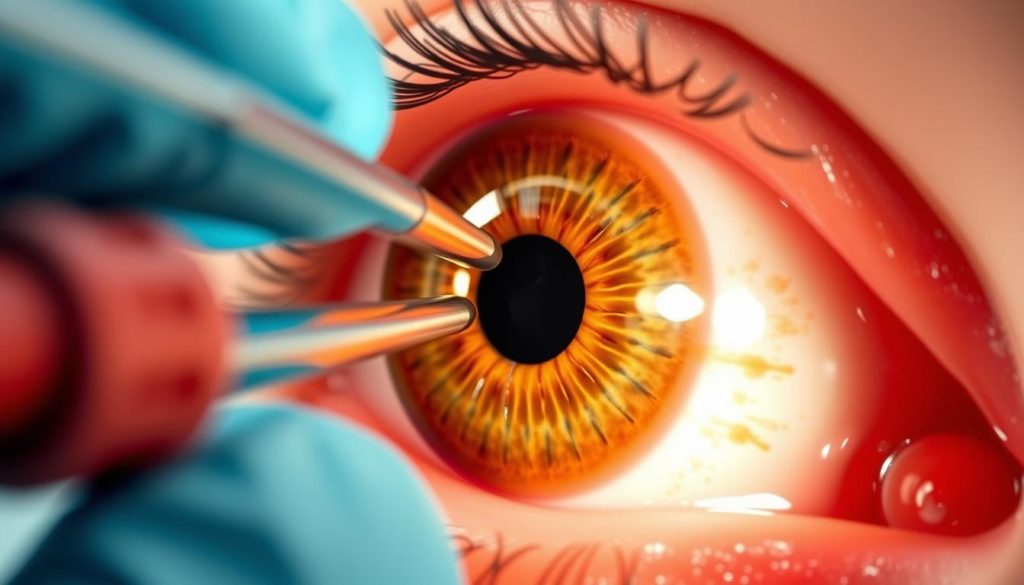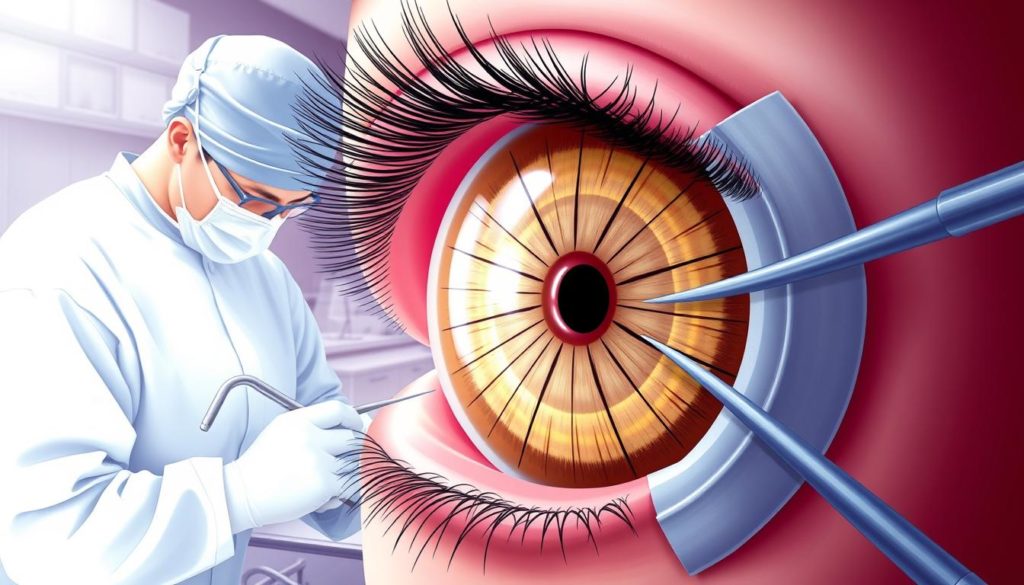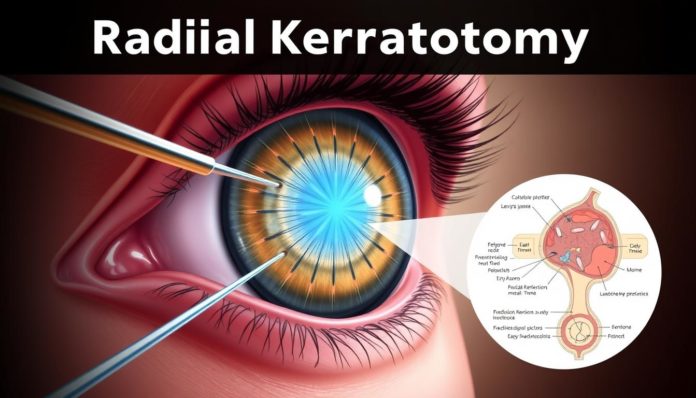Did you know Radial Keratotomy (RK) was done on nearly one million Americans in the 1980s? It might seem like an old procedure, but it still affects vision correction today.
Svyatoslav Fyodorov, a Russian ophthalmologist, created RK in the 1970s. It was a big step for treating myopia, or nearsightedness. This introduction will guide you through a detailed look at RK, its importance in vision correction, and what you’ll learn next.
Introduction to Radial Keratotomy (RK)
Radial Keratotomy (RK) is a surgery to fix nearsightedness. It was first used in the Soviet Union in the 1970s. It made the cornea flatter, helping many people see better.

History of RK
Dr. Svyatoslav Fyodorov started RK in Russia. He brought it to the US and other countries, changing eye surgery forever. In the 1980s and 1990s, RK got even better, making it safer and more effective.
Popularity and Usage
RK became very popular for fixing vision. It was simple and worked well. But, LASIK and PRK came along, making RK less common. Still, RK is a key part of eye surgery history, showing how far we’ve come.
How Radial Keratotomy (RK) Works
The Radial Keratotomy procedure aims to fix vision problems by cutting the cornea. It reshapes the cornea to make vision clearer. This method needs a lot of skill and careful planning.
Fundamentals of the Procedure
Understanding RK is key to its success. The surgery uses radial cuts to flatten the cornea. These cuts are made based on the patient’s vision needs, ensuring the best results.

Surgical Techniques
Doing a Radial Keratotomy needs a lot of skill and precise tools. Special instruments are used to make accurate cuts. These advancements have made the surgery safer and more precise, leading to better results for patients.
| Aspects of RK Procedure | Details |
|---|---|
| Incision Patterns | Radial, from the outer cornea toward the center |
| Precision Tools | Microsurgical blades, diamond knives |
| Advancements | Enhanced safety and improved accuracy |
The RK Procedure: Step-by-Step
Starting the RK step-by-step journey means going through several key steps. These steps are designed to improve your vision. This part will guide you through the steps before, during, and right after the surgery.
Knowing what happens at each part of the RK surgery process can make you feel more at ease. It shows how important it is to be well-prepared and for the surgery to be done with care.
- Preoperative Phase: First, you’ll have a detailed talk with your eye doctor. They will check your vision and eye health. This is to see if you can have the surgery. You’ll also get instructions on how to get ready for the surgery, like stopping contact lens use.
- Sterile Surgical Environment: On surgery day, you’ll get ready in a clean area to lower infection risk. You’ll get drops to numb your eye, making the surgery painless.
- Intraoperative Phase: The main part of the RK surgery process is when the surgeon makes precise cuts in your cornea. They use a special blade to flatten your cornea, aiming to improve your vision. It’s very important to do this right, as it affects how well the surgery works.
- Immediate Postoperative Care: Right after the surgery, you’ll be watched for a little while. You’ll get drops to prevent infection and swelling. You’ll also get clear instructions on how to care for your eyes to help you heal well.
The surgery is done by hand and needs a lot of skill. The surgeon’s skill is key to getting the best results for your vision. Following the care instructions and going to your follow-up appointments is also crucial for a good outcome.
In short, knowing the RK step-by-step process helps clear up any mystery about the surgery. It shows how carefully and precisely it’s done to improve your vision through this important technique.
Assessing RK Surgery Candidacy
To see if someone is right for Radial Keratotomy (RK), we look at many things. We make sure they meet the right criteria for a good result.
Eligibility Criteria
Knowing if you’re a good fit for RK is key. You should have stable vision and mild to moderate myopia. The thickness of the cornea is also very important. We check your eye health to make sure there are no problems that could affect the surgery or healing.
Preoperative Consultations
A detailed preoperative assessment is vital. During these talks, eye doctors do lots of tests. They measure corneal thickness, map the cornea, and look at your medical history. It’s also important to be mentally ready for the surgery.
Understanding what RK can and can’t do is crucial. This helps set realistic expectations and improves patient happiness.
RK Recovery: What to Expect
Getting Radial Keratotomy (RK) is just the start. Knowing about the RK recovery process is key for the best results. Let’s explore what patients can expect at each stage of RK recovery.
Immediate Postoperative Care
Right after RK surgery, some discomfort is normal. Good postoperative care is key to manage pain and avoid infection. Doctors usually suggest:
- Pain medications to ease discomfort
- Antibiotic eye drops to stop infections
- Rest and little eye movement for the first 24-48 hours.
- Avoiding hard activities until the surgeon says it’s okay.
Sticking to a strict postoperative care plan is important for healing.
Long-term Healing Process
The healing process takes time, with vision getting better slowly. Patients often see:
- Slow but steady improvement in vision over weeks or months
- Regular check-ups to watch healing and handle any issues
- Getting used to any temporary vision problems, like glare or halos.
Many patients are happy with RK’s long-term effects, even though recovery times vary. Here’s a common recovery timeline for RK:
“The recovery was smoother than I thought. With careful care, my vision got much better in three months.” – Anonymous patient
| Phase | Duration | Key Actions |
|---|---|---|
| Immediate Postoperative Phase | First 2-3 days | Pain management, prevent infection, rest |
| Initial Healing Phase | 1-4 weeks | Follow-up visits, monitor vision changes |
| Long-term Stabilization | 3 months to 1 year | Adaptation, possible minor adjustments |
While RK recovery takes time and effort, the chance for better long-term vision makes it worth it for many. Always listen to your surgeon’s advice for the best postoperative care.
RK Risks and Complications
Radial Keratotomy (RK) surgery can improve your vision a lot. But, it’s important to know the RK risks and Radial Keratotomy complications. Knowing these can help you prepare for what’s next.
Potential Side Effects
Like any surgery, RK has possible side effects. Some common ones include:
- Under-correction or over-correction of vision
- Glare and halos around lights, especially at night
- Fluctuating vision
- Infection or inflammation
Even with modern methods, about 10% of patients might face some complications.
Managing Complications
If you face complications after surgery, there are ways to manage them:
- More surgeries might be needed to fix your vision.
- Medicines like anti-inflammatory drugs and antibiotics can help with infections or inflammation.
- Seeing your eye doctor regularly can help keep an eye on long-term issues.
The table below shows how common different RK complications are:
| Complication | Likelihood | Treatment Options |
|---|---|---|
| Under-correction | 5% | Additional surgery |
| Over-correction | 3% | Laser touch-up |
| Glare and halos | 10% | Night vision aids |
| Infection | 1% | Antibiotics |
Knowing about RK risks and side effects can help you prepare. Always talk to your doctor about what’s best for you.
RK Benefits: Vision Correction and Beyond
Radial Keratotomy (RK) offers many advantages for those looking to improve their vision. It has both immediate and long-term benefits. This section explores the many perks of RK procedures.
Short-term Benefits
The effects of RK are clear right after the surgery. Patients often see drastic improvements in their vision. This means they can live with less need for glasses or contacts.
Many notice a big drop in myopia, making their vision clearer almost right away. These quick benefits make everyday tasks like reading and driving much simpler.
Long-term Benefits
The long-term vision improvement from RK is especially noteworthy. Research shows that many patients keep their vision stable for years after the surgery. This shows RK’s ability to provide lasting benefits.
This long-lasting clear vision can greatly improve your life. It goes beyond just correcting your vision. It also boosts your confidence and lets you do more things without glasses or contacts.
| Factors | RK Benefits |
|---|---|
| Immediate Impact | Significant reduction in refractive errors |
| Daily Life Improvements | Enhances reading, driving, and other visual tasks |
| Long-term Vision Stability | Maintained clear vision for years |
| Quality of Life | Increased confidence and activity engagement |
Alternatives to Radial Keratotomy (RK)
Today, there are many RK alternatives for better vision. Laser eye surgery and corrective lens implants are among the most popular.
Laser Eye Surgery
Laser eye surgery is now a top choice for vision correction. LASIK and PRK are the most common methods. They reshape the cornea to focus light better on the retina.
Those who choose laser eye surgery see quick results and lasting effects. The right choice between LASIK and PRK depends on your eye and lifestyle.
Lens Implants
Corrective lens implants are another good option. They include phakic intraocular lenses (IOLs) and refractive lens exchange (RLE). These implants are placed inside the eye to correct vision.
These implants are great for those not suited for laser eye surgery. They offer a permanent fix and reduce the need for glasses or contacts.
| Procedure | Benefits | Considerations |
|---|---|---|
| LASIK | Quick recovery, minimal discomfort | Suitable for patients with thicker corneas |
| PRK | Good for thin corneas, cost-effective | Longer recovery time |
| Phakic IOLs | Effective for high prescriptions | Surgical risks, long-term maintenance |
| RLE | Addresses presbyopia and cataracts | More invasive, longer recovery |
Understanding the Cost of RK Surgery
Thinking about Radial Keratotomy surgery? It’s key to know the costs involved. The cost can change based on where you are, the clinic’s reputation, and the surgeon’s skill. Look at prices in different places and clinics to find the best deal.
Procedure Costs
The cost for Radial Keratotomy can be between $1,500 and $4,000 per eye. This includes tests before surgery, the surgery itself, and follow-up visits. But, prices can go up at top clinics with skilled surgeons. The cost can also depend on the technology used and the care you receive.
Insurance Coverage
Understanding insurance for RK is important. Some policies might cover part of the cost, but many see it as an elective. Talk to your insurance to see what they cover. This will help you plan better.
Many clinics offer payment plans and financing. It’s good to ask about these options. This way, you can find a plan that works for your budget.
| Location | RK Procedure Cost | Insurance Coverage |
|---|---|---|
| California | $3,000 – $4,000 per eye | Limited coverage |
| Texas | $2,500 – $3,500 per eye | Partial coverage |
| Florida | $1,500 – $2,500 per eye | No Coverage |
Good financial planning is key for Radial Keratotomy. Think about the cost and insurance to make smart choices for your eyes.
Radial Keratotomy (RK) Overview: Is it Right for You?
Choosing Radial Keratotomy (RK) is a personal decision. It depends on your needs and lifestyle. Knowing what RK is and what it can do for you is key. First, think about what you want from your vision correction.
When looking at RK suitability, consider these important points:
- Your current vision and how much you expect it to improve.
- The potential risks and whether you’re comfortable with them.
- Your daily activities—do they require perfect vision?
It’s also important to have realistic expectations. A personalized approach means the procedure is tailored to you. Talking to your eye care professional is crucial to make sure your expectations are realistic.
Here’s a table that summarizes key points to help decide if RK is right for you:
| Candidate Profile | Ideal Characteristics | Considerations |
|---|---|---|
| Young Adults (20-40) |
|
|
| Middle-aged Adults (40-60) |
|
|
| Older Adults (60+) |
|
|
Thinking about these points can help you decide if RK is right for you. Talking to a trusted eye care specialist is a good way to understand the process better. They can help you make the best choice for your vision correction.
Radial Keratotomy (RK) in Retrospect: The Evolution of Vision Correction
Looking back, radial keratotomy (RK) was a big step forward in eye care. It was introduced in the 1970s and helped many people see better. But, as technology improved, new ways to correct vision came along.
At first, RK was seen as a simple and effective solution. But, LASIK and PRK soon came along. They offered better results and faster healing. This made RK less common in eye surgery today.
Even though RK is not as popular, it still played a key role in eye care history. It’s exciting to think about what new technologies might bring to vision correction. Maybe some old ideas from RK will come back in new ways. The field is always changing, and RK’s legacy is still felt today.
FAQ
What is Radial Keratotomy (RK)?
Radial Keratotomy, or RK, is a surgery to fix myopia, or nearsightedness. It makes radial cuts on the cornea to flatten it and improve vision.
Who developed the RK procedure?
Svyatoslav Fyodorov, a Russian ophthalmologist, developed RK in the 1970s. It was popular for those not wanting laser eye surgeries.
How did RK surgery evolve over time?
RK started in the Soviet Union and came to the U.S. before laser surgeries. It reshapes the cornea with precise cuts to correct vision.
What happens during an RK procedure?
RK makes radial cuts on the cornea with a scalpel. This reshapes the cornea to focus light better on the retina, improving vision.
Am I a good candidate for RK surgery?
RK is for those with moderate myopia and stable vision. A preoperative check with an ophthalmologist is needed to see if you’re a good candidate.
What is the recovery process for RK like?
After RK, you’ll need to manage pain and prevent infection. Vision takes weeks to months to stabilize. Follow-up visits are crucial for monitoring.
What are the risks and complications associated with RK?
Risks include under- or over-correction, glare, and changing vision. Complications might need more surgery or treatments. Always talk about risks with your eye doctor.
What are the benefits of RK surgery?
RK can greatly improve vision and correct it for the long term. Many see better quality of life and less need for glasses or contacts.
Are there alternatives to RK surgery?
Yes, LASIK, PRK, and intraocular lens implants are modern alternatives. The best choice depends on your eyes and what you prefer.
How much does RK surgery cost?
RK costs vary by location, clinic, and surgeon. Insurance often doesn’t cover it, but financing options might be available.
How do I decide if RK is right for me?
Think about your lifestyle, vision goals, and how you feel about risks. Talking to eye care professionals and understanding what to expect is key.
How has RK influenced modern vision correction techniques?
RK led to advancements in eye surgery, even though laser procedures have become more popular. Its principles still influence today’s techniques.


